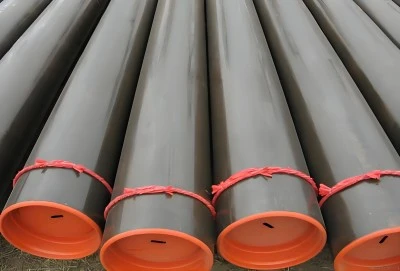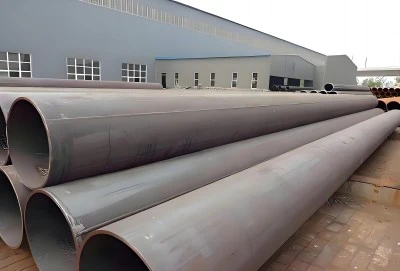API 5L X80 pipe has become increasingly important in modern oil and gas transportation systems due to its superior mechanical properties and cost-effectiveness. However, ensuring the longevity and safety of these pipelines requires comprehensive anti-corrosion measures. This article explores the critical aspects of protecting API 5L X80 pipes from various forms of corrosion, focusing on proven methods and technologies backed by scientific research.
|
|
|
Coating Protection
The first line of defense against corrosion in API 5L X80 pipes is the application of high-performance protective coatings. Fusion bonded epoxy powder (FBE) coating stands out as a primary choice due to its excellent adhesion properties and chemical resistance. The application process involves heating the steel pipe surface to approximately 200°C and electrostatically applying the powder, which melts and flows to form a continuous protective layer.
Three-layer polyethylene (3LPE) and three-layer polypropylene (3LPP) systems represent advanced coating technologies that provide enhanced protection. These systems typically consist of an epoxy primer layer, an adhesive middle layer, and an outer polyethylene or polypropylene layer. The 3LPE system offers superior resistance to soil stress and mechanical damage, while 3LPP provides additional protection at elevated operating temperatures up to 140°C.
Choosing the right coating for pipelines is essential to guaranteeing long-term defense against mechanical damage and corrosion. Soil conditions, operating temperature, and the mechanical stresses that the pipeline will experience over its lifetime are just a few of the environmental factors that must be considered in this process. Certain conditions, like extremely saline or acidic soils, can hasten corrosion, necessitating coatings with improved resistance. Similar to this, operating temperatures and pressure levels can affect how well coatings work; some materials work better in environments with high temperatures or fluctuating pressures. When selecting a coating, one must also take into account the mechanical stresses that the pipeline may experience, such as impacts, vibrations, or ground movement, in addition to these environmental factors.
Control of Microbial Corrosion
Microbiologically influenced corrosion (MIC) presents a significant challenge in pipeline operations. The presence of sulfate-reducing bacteria (SRB) and nitrate-reducing bacteria (NRB) can accelerate corrosion rates dramatically. These microorganisms thrive in anaerobic conditions, often forming biofilms that create localized corrosion cells on the pipe surface.
Effective MIC control strategies include regular biocide treatment programs, with careful selection of biocides based on bacterial population monitoring. Chemical treatment programs typically employ quaternary ammonium compounds or glutaraldehyde-based API 5L X80 pipe. The dosing frequency and concentration must be optimized to maintain effective control while minimizing environmental impact and operational costs.
To evaluate the efficacy of treatment approaches in diverse settings, especially water systems, routine monitoring of bacterial populations is crucial. The ability to precisely identify and quantify bacterial species has made molecular microbiological methods (MMM) indispensable in this process. Even at low concentrations, microbial communities can be quickly and accurately detected thanks to methods like next-generation sequencing, fluorescence in situ hybridization (FISH), and polymerase chain reaction (PCR). Researchers and engineers can assess whether treatment methods like disinfection or filtration are producing the intended results by tracking changes in microbial diversity and abundance through the monitoring of bacterial populations over time. Additionally, by identifying the presence of harmful bacteria, these techniques can provide an early warning of possible health hazards.
Electrochemical Protection
Cathodic protection systems play a crucial role in preventing external corrosion of buried pipelines. Research has shown that DC stray currents can significantly impact the corrosion behavior of API 5L X80 pipe. The implementation of impressed current cathodic protection (ICCP) systems requires careful consideration of potential gradients and current distribution to ensure effective protection without causing coating disbondment.
Studies have demonstrated that maintaining a pipe-to-soil potential within the range of -850 mV to -1150 mV (versus Cu/CuSO4 reference electrode) provides optimal protection while minimizing the risk of hydrogen embrittlement. The presence of DC stray currents can shift these potentials, necessitating regular monitoring and adjustment of protection parameters.
Test stations installed at regular intervals along the pipeline route enable measurement of protection potentials and current requirements. Modern remote monitoring systems allow for real-time tracking of protection levels and rapid response to any protection system failures.
Corrosion Monitoring and Detection
Comprehensive integrity management programs incorporate various inspection and monitoring techniques. In-line inspection (ILI) tools, equipped with magnetic flux leakage (MFL) or ultrasonic technology, provide detailed information about pipeline wall thickness and potential corrosion defects. These intelligent pig runs should be conducted at intervals determined by risk assessment and historical corrosion rates.
Regular external corrosion direct assessment (ECDA) surveys help identify areas of coating damage or deterioration. This includes close interval potential surveys (CIPS), direct current voltage gradient (DCVG) surveys, and alternating current voltage gradient (ACVG) measurements. Soil resistivity measurements and analysis of soil samples for corrosive elements provide additional data for corrosion risk assessment.
Laboratory testing of pipe samples includes various mechanical tests to evaluate material properties and corrosion resistance. Drop Weight Tear Testing (DWTT) assesses the material's resistance to brittle fracture, while hydrostatic testing confirms the pipeline's pressure-containing capability.
API 5L X80 Pipe For Sale
LONGMA GROUP specializes in manufacturing API 5L X80 pipes meeting both PSL1 and PSL2 specifications. The manufacturing process incorporates strict quality control measures to ensure consistent mechanical properties and corrosion resistance. All pipes undergo rigorous testing and inspection before shipment, including ultrasonic testing, radiographic inspection, and hydrostatic testing as per API specifications. If you are choosing your product manufacturers, welcome to contact us at info@longma-group.com.














